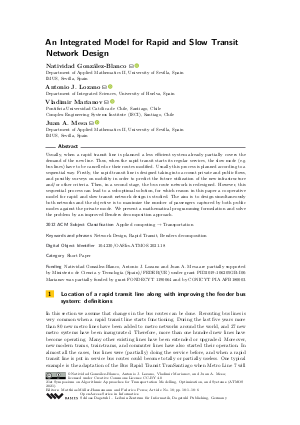An Integrated Model for Rapid and Slow Transit Network Design (Short Paper)
Authors
Natividad González-Blanco  ,
Antonio J. Lozano
,
Antonio J. Lozano  ,
Vladimir Marianov
,
Vladimir Marianov  ,
Juan A. Mesa
,
Juan A. Mesa 
-
Part of:
Volume:
21st Symposium on Algorithmic Approaches for Transportation Modelling, Optimization, and Systems (ATMOS 2021)
Part of: Series: Open Access Series in Informatics (OASIcs)
Part of: Conference: Symposium on Algorithmic Approaches for Transportation Modelling, Optimization, and Systems (ATMOS) - License:
 Creative Commons Attribution 4.0 International license
Creative Commons Attribution 4.0 International license
- Publication Date: 2021-09-27
File

PDF
OASIcs.ATMOS.2021.18.pdf
- Filesize: 462 kB
- 6 pages
Document Identifiers
Subject Classification
ACM Subject Classification
- Applied computing → Transportation
Keywords
- Network Design
- Rapid Transit
- Benders decomposition
Metrics
- Access Statistics
-
Total Accesses (updated on a weekly basis)
0PDF Downloads0Metadata Views
Abstract
Usually, when a rapid transit line is planned a less efficient system already partially covers the demand of the new line. Thus, when the rapid transit starts its regular services, the slow mode (e.g. bus lines) have to be cancelled or their routes modified. Usually this process is planned according to a sequential way. Firstly, the rapid transit line is designed taking into account private and public flows, and possibly surveys on mobility in order to predict the future utilization of the new infrastructure and/or other criteria. Then, in a second stage, the bus route network is redesigned. However, this sequential process can lead to a suboptimal solution, for which reason in this paper a cooperative model for rapid and slow transit network design is studied. The aim is to design simultaneously both networks and the objective is to maximize the number of passengers captured by both public modes against the private mode. We present a mathematical programming formulation and solve the problem by an improved Benders decomposition approach.
Cite As Get BibTex
Natividad González-Blanco, Antonio J. Lozano, Vladimir Marianov, and Juan A. Mesa. An Integrated Model for Rapid and Slow Transit Network Design (Short Paper). In 21st Symposium on Algorithmic Approaches for Transportation Modelling, Optimization, and Systems (ATMOS 2021). Open Access Series in Informatics (OASIcs), Volume 96, pp. 18:1-18:6, Schloss Dagstuhl – Leibniz-Zentrum für Informatik (2021)
https://doi.org/10.4230/OASIcs.ATMOS.2021.18
BibTex
@InProceedings{gonzalezblanco_et_al:OASIcs.ATMOS.2021.18,
author = {Gonz\'{a}lez-Blanco, Natividad and Lozano, Antonio J. and Marianov, Vladimir and Mesa, Juan A.},
title = {{An Integrated Model for Rapid and Slow Transit Network Design}},
booktitle = {21st Symposium on Algorithmic Approaches for Transportation Modelling, Optimization, and Systems (ATMOS 2021)},
pages = {18:1--18:6},
series = {Open Access Series in Informatics (OASIcs)},
ISBN = {978-3-95977-213-6},
ISSN = {2190-6807},
year = {2021},
volume = {96},
editor = {M\"{u}ller-Hannemann, Matthias and Perea, Federico},
publisher = {Schloss Dagstuhl -- Leibniz-Zentrum f{\"u}r Informatik},
address = {Dagstuhl, Germany},
URL = {https://drops.dagstuhl.de/entities/document/10.4230/OASIcs.ATMOS.2021.18},
URN = {urn:nbn:de:0030-drops-148871},
doi = {10.4230/OASIcs.ATMOS.2021.18},
annote = {Keywords: Network Design, Rapid Transit, Benders decomposition}
}
Author Details
- Department of Applied Mathematics II, University of Sevilla, Spain
- IMUS, Sevilla, Spain
- Pontificia Universidad Católica de Chile, Santiago, Chile
- Complex Engineering Systems Institute (ISCI), Santiago, Chile
Funding
Natividad González-Blanco, Antonio J. Lozano and Juan A. Mesa are partially supported by Ministerio de Ciencia y Tecnología (Spain)/FEDER(UE) under grant PID2019-106205GB-I00. Marianov was partially funded by grant FONDECYT 1190064 and by CONICYT PIA AFB180003.
References
-
J Benders. Partitioning procedures for solving mixed-variables programming problems. Numerische mathematik, 4(1):238-252, 1962.

-
M Conforti and L. A Wolsey. "Facet" separation with one linear program. Mathematical Programming, 178(1):361-380, 2019.

-
Lian-bo Deng, Wei Gao, Wen-liang Zhou, and Tian-zhen Lai. Optimal design of feeder-bus network related to urban rail line based on transfer system. Procedia-Social and Behavioral Sciences, 96:2383-2394, 2013.

-
Gilbert Laporte and Juan A Mesa. The design of rapid transit networks. In G. Laporte, S. Nickel, and F. Saldanha da Gama, editors, Location science, chapter 24, pages 685-701. Springer, 2020.

